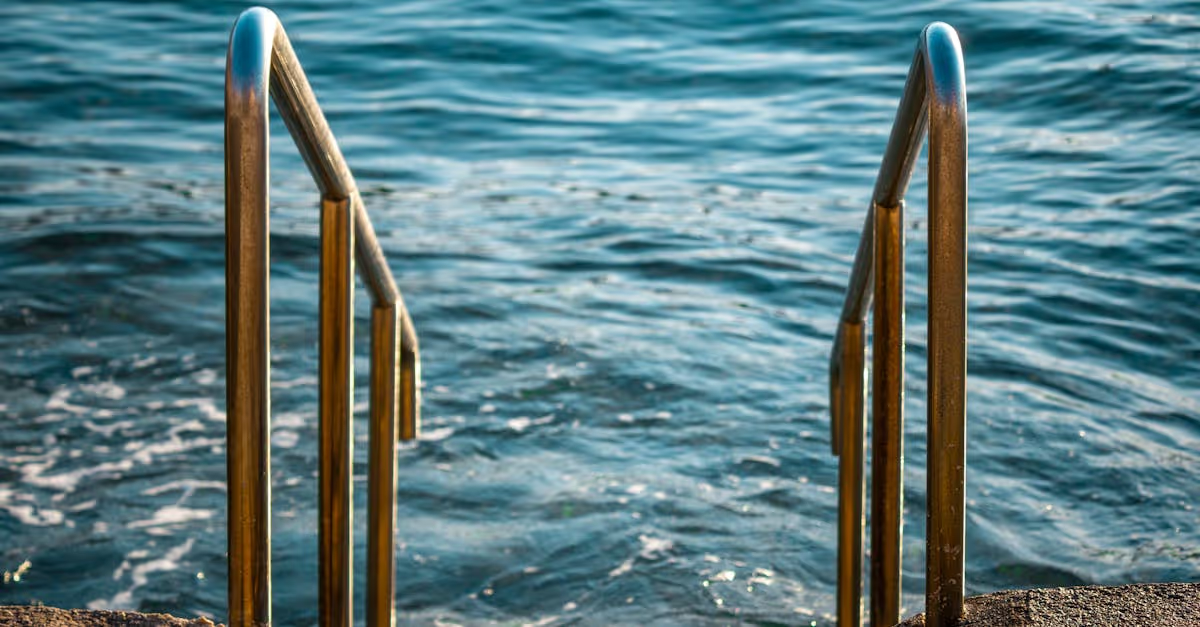Key Takeaways
- Emphasize Safety: Sturdy pool ladders and handrails are essential for preventing accidents, particularly slips and falls, which account for thousands of pool-related injuries annually.
- Choose the Right Features: Different types of ladders and handrails, such as A-frame and inground models, cater to various pool designs and user needs, enhancing accessibility for all, including children and individuals with mobility challenges.
- Follow Proper Installation Steps: Correct installation of pool ladders involves gathering necessary tools and materials, carefully marking positions, drilling holes, and securing anchors to ensure stability and safety.
- Conduct Regular Maintenance: Routine checks for rust, loose fittings, and general wear are crucial for keeping ladders and handrails in good condition, thereby reducing risks associated with pool use.
- Address Repairs Promptly: Common issues like rust and wobbly fittings should be addressed quickly. Understanding when to seek professional help can ensure compliance with safety regulations and prevent further damage.
- Enhance Accessibility: Installing easy-to-grip handrails and considering additional features like transfer benches can significantly improve access for all pool users, fostering a more inclusive environment.
When it comes to pool safety, the importance of sturdy ladders and handrails can't be overstated. Did you know that nearly 5,000 pool-related injuries occur each year, many of which involve slips and falls? Ensuring our pool areas are equipped with reliable and accessible features is crucial for preventing accidents and promoting safety for everyone, especially children and elderly guests.
Overview of Pool Ladders and Handrails
Pool ladders and handrails play a crucial role in promoting safety and accessibility around pools. With safety being a top priority, selecting appropriate features matters to all of us—an estimated 5,000 pool-related injuries occur annually, and many of these incidents stem from trips and falls.
Importance of Safety and Accessibility
Safety and accessibility create a welcoming pool environment for everyone. They allow children, elderly guests, and those with mobility challenges to enjoy the water without fear. Strong handrails and sturdy ladders offer stability, giving everyone a dependable way to enter and exit the pool. Incorporating these features reduces accidents and enhances overall enjoyment. We recognize that a few extra safety measures can make a difference. What safety features have you found most effective in a pool area?
Types of Pool Ladders and Handrails
Various types of pool ladders and handrails cater to different needs. Options include:
- A-Frame Ladders: These are suitable for above-ground pools and provide a stable structure for entering.
- Inground Pool Ladders: Crafted for inground installations, these ladders ensure secure access.
- Deck-mounted Handrails: Attached to the pool deck, these offer additional support for users as they move in and out of the pool.
- Grab Rails: Typically used alongside ladders, grab rails provide extra stability and can be installed in various spots around the pool.
Selecting the right type depends on our pool's specific design and our guests' needs. Evaluating options with our community’s feedback can lead us to optimal choices that benefit everyone. What types of ladders or handrails have you used successfully in your pool area?
Installation of Pool Ladders
Installing pool ladders involves a few essential tools and materials. Having the right items on hand makes this process smoother and more efficient.
Required Tools and Materials
- Tools:
- Phillips and standard screwdriver or bit
- Drill
- 1-1/2” hole saw
- Masonry drill bit (if working on concrete decks)
- Pencil
- Hacksaw (for adjusting ladder height if necessary)
- Materials:
- Pool ladder kit (includes ladder body, handrails, deck flanges, and anchors)
- Anchor sockets (can be aluminum or bronze)
- Deck flanges
- Escutcheons
- Bonding wire (for electrical grounding)
- Pea gravel or PVC sleeves (optional for core drill method)
- Concrete or wood anchors (needed based on deck type)
Gathering these items helps in efficiently setting up the pool ladder and boosting its safety features.
Step-by-Step Installation Process
- Handrail Assembly:
Attach the aluminum handrails to the ladder body. Make sure the shorter end of the handrail is on the ladder body while the longer end is ready for installation through the deck.
- Marking the Deck:
Use a pencil to mark the positions where the ladder will connect to the deck. This ensures precise drilling and alignment.
- Drilling Holes:
Use the drill with the masonry bit or hole saw to create holes based on the marks made. Drill carefully to avoid damaging the deck.
- Inserting Anchor Sockets:
Insert the anchor sockets into the drilled holes. Ensure proper alignment for secure attachment.
- Securing the Ladder:
Place the ladder in position and fasten it using the deck flanges and screws. Tighten firmly to avoid any wobble.
- Final Checks:
Check all connections and ensure everything is secure. Test the ladder to confirm stability before use.
Following these steps brings not just safety but accessibility to our pool area, allowing everyone to enjoy it without hesitation.
Repairing Pool Ladders and Handrails
Pool ladders and handrails sometimes face wear and tear from regular use. Keeping them in good condition remains vital for safety and accessibility. Quick repairs can prevent slips and falls, preserving the joy of swimming for everyone.
Common Issues and Solutions
Common issues include rust, loose fittings, or cracks in the ladder. Rust on metal components affects durability and can lead to dangerous situations. We tackle this by sanding down the rust, applying rust-inhibiting paint, and sealing cracked areas with an appropriate sealant.
Loose fittings can create a wobble, risking fall injuries. Tightening bolts and using lock washers helps. If you discover cracks or structural weaknesses in the ladder structure, replace the damaged parts to maintain safety.
For handrails, check for stability and any signs of corrosion. A wobbly handrail can transform a safe entry point into a potential hazard. Tightening screws or replacing fittings resolves most issues. If we find major faults, replacing the handrail altogether might be necessary.
When to Seek Professional Help
Sometimes, repairs go beyond what we can handle. If ladders or handrails exhibit significant rust or damage despite our efforts, seeking professional help becomes essential. Professionals assess the situation accurately and provide solutions that enhance safety.
Additionally, local codes may regulate the installation and maintenance of pool safety features. Consulting with an expert aligns our work with these standards, ensuring compliance and safety for pool users.
Leaning more toward DIY repairs can save costs, yet knowing our limits is just as crucial. When in doubt, hiring a professional saves time and may prevent larger expenses down the road. Investing in quality repairs showcases our commitment to keeping our pool area safe and accessible for everyone – especially those who might need it most.
Safety Tips for Pool Ladders and Handrails
To maintain a safe and enjoyable pool environment, we need effective strategies for pool ladders and handrails.
Maintenance Best Practices
Regular maintenance keeps our ladders and handrails in top condition. We check for damage, rust, and loose fittings monthly. Tighten loose bolts with a power drill for stability. Testing the ladder before each use is crucial. We shake it gently side to side, ensuring it feels steady. Steps should align properly, entering the water without any gaps.
Cleaning is just as essential. We rely on a non-abrasive cleaner mixed with warm water to scrub ladders and rails. This removes debris and stains while preserving the finish. After scrubbing, rinsing with fresh water ensures no cleaner residue remains. Applying a high-quality protectant can also prevent corrosion and extend the life of our equipment.
Enhancing Accessibility Features
Accessibility matters for everyone using our pool. We can install easy-to-grip handrails that assist those with mobility challenges. These handrails should be positioned at a height that accommodates all users. A-frame ladders offer an extra boost for individuals needing assistance entering or exiting the pool.
Installing a transfer bench can also support safe entry and exit for those who may struggle. Regular assessments of these features help us identify necessary updates. We consider community feedback to choose suitable options. Each improvement fosters a welcoming space for all guests, making pool days more enjoyable and safe.
As we prioritize safety and accessibility, we create a space that everyone can appreciate and enjoy without hesitation.
Conclusion
Prioritizing the installation and maintenance of pool ladders and handrails is essential for creating a safe and accessible environment. By regularly checking for wear and tear and addressing issues promptly, we can significantly reduce the risk of accidents.
Implementing user-friendly features not only enhances safety but also ensures that everyone can enjoy the pool without hesitation. Let’s commit to fostering a welcoming atmosphere that caters to all guests, especially those with mobility challenges.
With the right tools and knowledge, we can make our pool areas safer and more enjoyable for everyone.
Frequently Asked Questions
What safety features should I include for my pool area?
To enhance pool safety, include sturdy ladders, handrails, and grab rails. These features help prevent slips and falls while making the pool more accessible for children and individuals with mobility challenges. Regular maintenance and community feedback can guide you in selecting the best options for your needs.
How can I prevent pool-related injuries?
To prevent pool injuries, ensure you have reliable safety features like ladders and handrails. Conduct regular maintenance checks, teach pool safety rules to all users, and supervise children at all times. These practices will significantly reduce the risk of accidents around the pool.
What is the best type of pool ladder?
The best type of pool ladder depends on your pool type and user needs. A-frame ladders are suitable for above-ground pools, while inground pool ladders and deck-mounted handrails offer stability for in-ground pools. Evaluate community feedback to find the most effective option.
How do I install a pool ladder?
To install a pool ladder, gather necessary tools like screwdrivers and drills. Follow these steps: assemble handrails, mark the deck for drilling, insert anchor sockets, secure the ladder, and conduct stability checks. Proper installation improves safety and accessibility for all users.
How often should I maintain my pool ladders and handrails?
Regular maintenance is crucial for safety. Check pool ladders and handrails monthly for damage, rust, and loose fittings. Ensure stability before each use. Promptly address any issues to keep the pool area safe for everyone.
When should I seek professional help for repairs?
Seek professional help for significant repairs or if you encounter severe rust, cracks, or instability. Consulting an expert ensures that repairs meet safety standards and local codes, providing a safe pool environment for all users.
What cleaning methods are recommended for pool ladders and handrails?
Use non-abrasive cleaning solutions to avoid damaging the finish of pool ladders and handrails. Regularly clean and apply protectants to prevent corrosion. This maintenance will extend the life of your pool safety features.
How can I enhance accessibility for pool users?
Enhance accessibility by installing easy-to-grip handrails and transfer benches. Ensure all safety features cater to users with mobility challenges. Regular assessments and feedback from the community will help create a welcoming and accessible pool environment.






